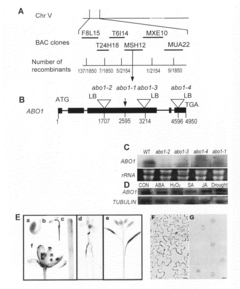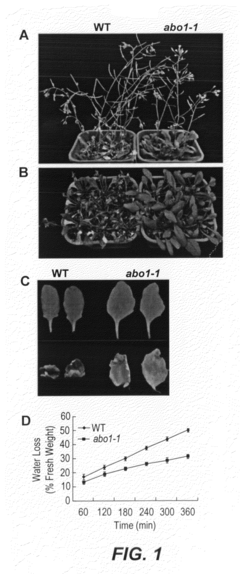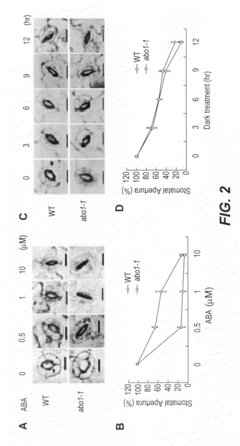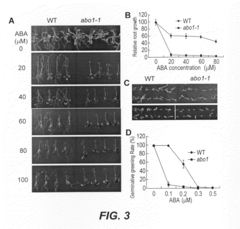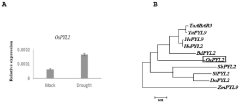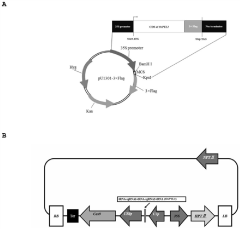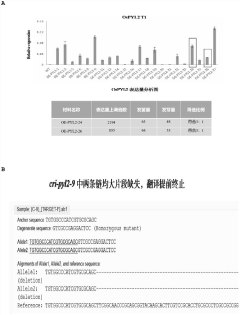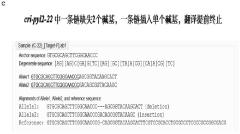Future Progressions in Abscisic Acid Research: Drought Resistance
JUL 14, 20259 MIN READ
Generate Your Research Report Instantly with AI Agent
Patsnap Eureka helps you evaluate technical feasibility & market potential.
ABA Research Background and Objectives
Abscisic acid (ABA) research has been a cornerstone in understanding plant stress responses, particularly in relation to drought resistance. The journey of ABA research began in the 1960s with its isolation and identification as a plant hormone. Since then, our understanding of ABA's role in plant physiology has evolved significantly, shaping the landscape of agricultural biotechnology and crop improvement strategies.
The primary objective of current and future ABA research is to enhance drought resistance in crops, a critical goal in the face of global climate change and increasing water scarcity. This aim is driven by the urgent need to develop more resilient and sustainable agricultural systems capable of withstanding prolonged periods of water deficit without significant yield losses.
ABA research has progressed through several key phases, each building upon previous discoveries. Initial studies focused on understanding ABA's chemical structure and basic physiological effects. This was followed by investigations into ABA biosynthesis pathways and signaling mechanisms. Recent advancements have delved into the molecular intricacies of ABA perception and signal transduction, uncovering a complex network of receptors, kinases, and transcription factors.
The current trajectory of ABA research is aimed at translating molecular insights into practical applications for crop improvement. This includes developing ABA-responsive genetic markers for breeding programs, engineering ABA-related genes to enhance drought tolerance, and exploring the potential of ABA analogs as agrochemicals to induce stress resistance in crops.
Emerging trends in ABA research include the integration of systems biology approaches to understand the broader context of ABA signaling within plant stress responses. This involves studying the interplay between ABA and other phytohormones, as well as investigating the role of ABA in regulating epigenetic modifications that influence long-term stress adaptation.
Another significant objective is to elucidate the spatial and temporal dynamics of ABA signaling at the cellular and whole-plant levels. Advanced imaging techniques and single-cell omics approaches are being employed to achieve this goal, providing unprecedented resolution in understanding ABA's mode of action.
As we look to the future, the objectives of ABA research are expanding to include the development of climate-resilient crops through targeted manipulation of ABA-related pathways. This encompasses efforts to fine-tune ABA responses to optimize the balance between drought resistance and overall plant productivity, addressing the often-observed trade-off between stress tolerance and yield potential.
The primary objective of current and future ABA research is to enhance drought resistance in crops, a critical goal in the face of global climate change and increasing water scarcity. This aim is driven by the urgent need to develop more resilient and sustainable agricultural systems capable of withstanding prolonged periods of water deficit without significant yield losses.
ABA research has progressed through several key phases, each building upon previous discoveries. Initial studies focused on understanding ABA's chemical structure and basic physiological effects. This was followed by investigations into ABA biosynthesis pathways and signaling mechanisms. Recent advancements have delved into the molecular intricacies of ABA perception and signal transduction, uncovering a complex network of receptors, kinases, and transcription factors.
The current trajectory of ABA research is aimed at translating molecular insights into practical applications for crop improvement. This includes developing ABA-responsive genetic markers for breeding programs, engineering ABA-related genes to enhance drought tolerance, and exploring the potential of ABA analogs as agrochemicals to induce stress resistance in crops.
Emerging trends in ABA research include the integration of systems biology approaches to understand the broader context of ABA signaling within plant stress responses. This involves studying the interplay between ABA and other phytohormones, as well as investigating the role of ABA in regulating epigenetic modifications that influence long-term stress adaptation.
Another significant objective is to elucidate the spatial and temporal dynamics of ABA signaling at the cellular and whole-plant levels. Advanced imaging techniques and single-cell omics approaches are being employed to achieve this goal, providing unprecedented resolution in understanding ABA's mode of action.
As we look to the future, the objectives of ABA research are expanding to include the development of climate-resilient crops through targeted manipulation of ABA-related pathways. This encompasses efforts to fine-tune ABA responses to optimize the balance between drought resistance and overall plant productivity, addressing the often-observed trade-off between stress tolerance and yield potential.
Market Analysis for Drought-Resistant Crops
The market for drought-resistant crops has been experiencing significant growth in recent years, driven by increasing concerns over climate change and water scarcity. As global temperatures rise and precipitation patterns become more erratic, farmers and agricultural businesses are seeking innovative solutions to maintain crop yields in the face of drought conditions.
The global market for drought-resistant seeds is projected to reach substantial value in the coming years, with a compound annual growth rate (CAGR) outpacing that of traditional seed markets. This growth is primarily fueled by the adoption of genetically modified (GM) and hybrid seeds that incorporate drought-tolerant traits.
Key crops driving market demand include corn, soybeans, cotton, and wheat. These staple crops are essential for global food security and represent a significant portion of agricultural production worldwide. The development of drought-resistant varieties for these crops has become a priority for both seed companies and research institutions.
Geographically, North America and Europe currently lead the market for drought-resistant crops, owing to advanced agricultural practices and higher adoption rates of GM technologies. However, emerging economies in Asia-Pacific and Africa are expected to witness the fastest growth in the coming years, as these regions face increasing water stress and food security challenges.
The market is characterized by intense competition among major agrochemical and seed companies, with key players investing heavily in research and development to gain a competitive edge. Collaborations between private companies and public research institutions are becoming more common, accelerating the development of new drought-resistant varieties.
Consumer acceptance of GM crops remains a challenge in some regions, particularly in Europe. This has led to increased focus on developing drought-resistant varieties through traditional breeding methods and advanced non-GM technologies, such as marker-assisted selection.
Government policies and regulations play a crucial role in shaping the market landscape. Many countries have implemented supportive policies to encourage the adoption of drought-resistant crops, including subsidies for farmers and funding for research initiatives. However, regulatory hurdles for GM crops in certain regions continue to impact market growth.
The increasing prevalence of extreme weather events and prolonged droughts is expected to drive further demand for drought-resistant crops. As climate change continues to affect agricultural productivity, the market for these resilient varieties is likely to expand, offering significant opportunities for seed companies, biotechnology firms, and agricultural research institutions.
The global market for drought-resistant seeds is projected to reach substantial value in the coming years, with a compound annual growth rate (CAGR) outpacing that of traditional seed markets. This growth is primarily fueled by the adoption of genetically modified (GM) and hybrid seeds that incorporate drought-tolerant traits.
Key crops driving market demand include corn, soybeans, cotton, and wheat. These staple crops are essential for global food security and represent a significant portion of agricultural production worldwide. The development of drought-resistant varieties for these crops has become a priority for both seed companies and research institutions.
Geographically, North America and Europe currently lead the market for drought-resistant crops, owing to advanced agricultural practices and higher adoption rates of GM technologies. However, emerging economies in Asia-Pacific and Africa are expected to witness the fastest growth in the coming years, as these regions face increasing water stress and food security challenges.
The market is characterized by intense competition among major agrochemical and seed companies, with key players investing heavily in research and development to gain a competitive edge. Collaborations between private companies and public research institutions are becoming more common, accelerating the development of new drought-resistant varieties.
Consumer acceptance of GM crops remains a challenge in some regions, particularly in Europe. This has led to increased focus on developing drought-resistant varieties through traditional breeding methods and advanced non-GM technologies, such as marker-assisted selection.
Government policies and regulations play a crucial role in shaping the market landscape. Many countries have implemented supportive policies to encourage the adoption of drought-resistant crops, including subsidies for farmers and funding for research initiatives. However, regulatory hurdles for GM crops in certain regions continue to impact market growth.
The increasing prevalence of extreme weather events and prolonged droughts is expected to drive further demand for drought-resistant crops. As climate change continues to affect agricultural productivity, the market for these resilient varieties is likely to expand, offering significant opportunities for seed companies, biotechnology firms, and agricultural research institutions.
Current ABA Signaling Pathway Knowledge
The current understanding of the ABA signaling pathway has significantly advanced in recent years, providing crucial insights into drought resistance mechanisms in plants. At the core of this pathway is the PYR/PYL/RCAR family of ABA receptors, which play a pivotal role in initiating the signaling cascade upon ABA binding.
When ABA levels increase during drought stress, these receptors undergo conformational changes, enabling them to interact with and inhibit PP2C phosphatases. This inhibition releases SnRK2 protein kinases from negative regulation, allowing them to phosphorylate downstream targets, including transcription factors and ion channels.
The activation of ABA-responsive element binding factors (ABFs) by SnRK2 kinases leads to the transcription of numerous drought-responsive genes. These genes are involved in various cellular processes, such as osmolyte production, antioxidant defense, and stomatal closure, all of which contribute to enhanced drought tolerance.
Recent research has elucidated the importance of ABA-induced stomatal closure in conserving water during drought stress. This process involves the regulation of ion channels, particularly SLAC1 and KAT1, which control the movement of ions across guard cell membranes. The phosphorylation of these channels by SnRK2 kinases alters their activity, leading to stomatal closure and reduced water loss.
Furthermore, the ABA signaling pathway has been shown to interact with other stress response pathways, including those mediated by calcium, reactive oxygen species (ROS), and other phytohormones. This crosstalk allows for a more nuanced and effective response to drought stress, integrating multiple cellular signals to fine-tune the plant's adaptive strategies.
Advances in structural biology have provided detailed insights into the molecular interactions within the ABA signaling pathway. High-resolution structures of ABA receptors, PP2C phosphatases, and SnRK2 kinases have revealed the precise mechanisms of their interactions and regulation, paving the way for targeted manipulations to enhance drought resistance.
Recent studies have also highlighted the role of post-translational modifications, such as ubiquitination and SUMOylation, in modulating the activity and stability of key components of the ABA signaling pathway. These modifications add another layer of complexity to the regulation of drought responses and offer potential targets for improving plant resilience.
When ABA levels increase during drought stress, these receptors undergo conformational changes, enabling them to interact with and inhibit PP2C phosphatases. This inhibition releases SnRK2 protein kinases from negative regulation, allowing them to phosphorylate downstream targets, including transcription factors and ion channels.
The activation of ABA-responsive element binding factors (ABFs) by SnRK2 kinases leads to the transcription of numerous drought-responsive genes. These genes are involved in various cellular processes, such as osmolyte production, antioxidant defense, and stomatal closure, all of which contribute to enhanced drought tolerance.
Recent research has elucidated the importance of ABA-induced stomatal closure in conserving water during drought stress. This process involves the regulation of ion channels, particularly SLAC1 and KAT1, which control the movement of ions across guard cell membranes. The phosphorylation of these channels by SnRK2 kinases alters their activity, leading to stomatal closure and reduced water loss.
Furthermore, the ABA signaling pathway has been shown to interact with other stress response pathways, including those mediated by calcium, reactive oxygen species (ROS), and other phytohormones. This crosstalk allows for a more nuanced and effective response to drought stress, integrating multiple cellular signals to fine-tune the plant's adaptive strategies.
Advances in structural biology have provided detailed insights into the molecular interactions within the ABA signaling pathway. High-resolution structures of ABA receptors, PP2C phosphatases, and SnRK2 kinases have revealed the precise mechanisms of their interactions and regulation, paving the way for targeted manipulations to enhance drought resistance.
Recent studies have also highlighted the role of post-translational modifications, such as ubiquitination and SUMOylation, in modulating the activity and stability of key components of the ABA signaling pathway. These modifications add another layer of complexity to the regulation of drought responses and offer potential targets for improving plant resilience.
Current ABA-based Drought Resistance Strategies
01 Genetic modification for enhanced ABA signaling
Genetic engineering techniques are used to modify plants for improved abscisic acid (ABA) signaling pathways. This enhances the plant's ability to respond to drought stress by regulating stomatal closure and other drought resistance mechanisms. The modified plants show increased drought tolerance and improved water use efficiency.- Genetic modification for enhanced ABA signaling: Genetic engineering techniques are used to modify plants for improved abscisic acid (ABA) signaling pathways. This enhances drought resistance by optimizing water use efficiency and stress responses. Modified genes may include those involved in ABA biosynthesis, perception, or downstream signaling components.
- Exogenous application of ABA or analogs: Application of ABA or its synthetic analogs to plants can improve drought resistance. These compounds can be applied through foliar sprays, seed treatments, or soil drenches. This method triggers drought response mechanisms, such as stomatal closure and osmotic adjustment, without genetic modification.
- ABA-responsive gene identification and regulation: Identification and characterization of genes responsive to ABA during drought stress. This includes studying transcription factors, stress-responsive proteins, and regulatory elements. Understanding these genes helps in developing targeted approaches for enhancing drought resistance through genetic engineering or breeding programs.
- ABA-mediated physiological adaptations: Research on ABA-induced physiological changes that contribute to drought resistance. This includes studying mechanisms such as root architecture modification, leaf senescence regulation, and osmolyte accumulation. Understanding these adaptations helps in developing strategies to enhance plant survival under water-limited conditions.
- Integration of ABA signaling with other stress pathways: Investigation of cross-talk between ABA signaling and other stress response pathways, such as those involved in heat or salt tolerance. This integrated approach aims to develop plants with broad stress resistance by manipulating common regulatory nodes or enhancing synergistic effects between different stress response mechanisms.
02 Exogenous application of ABA
External application of abscisic acid or its analogs to plants can improve their drought resistance. This method involves spraying or treating plants with ABA solutions, which triggers drought response mechanisms such as stomatal closure and osmotic adjustment. The treatment can be applied at various growth stages to enhance drought tolerance.Expand Specific Solutions03 ABA-responsive gene identification and manipulation
Identification and manipulation of genes involved in ABA biosynthesis, signaling, or response pathways. This includes discovering new ABA-responsive genes, studying their functions, and manipulating their expression to enhance drought resistance in plants. The approach often involves transcriptomics and functional genomics studies.Expand Specific Solutions04 ABA-mediated stress memory in plants
Research on how plants retain 'memory' of previous drought stress through ABA-mediated mechanisms. This involves studying epigenetic changes, priming effects, and long-term adaptations that allow plants to respond more efficiently to subsequent drought events. Understanding these mechanisms can lead to the development of crops with improved long-term drought resistance.Expand Specific Solutions05 Interaction of ABA with other phytohormones for drought resistance
Investigation of the crosstalk between ABA and other plant hormones in drought stress responses. This includes studying how ABA interacts with hormones like ethylene, jasmonic acid, and auxins to regulate drought resistance. Understanding these interactions can lead to more comprehensive strategies for enhancing plant drought tolerance.Expand Specific Solutions
Key Players in ABA and Drought Research
The research on abscisic acid (ABA) for drought resistance is in a dynamic phase, with significant market potential as climate change intensifies water scarcity issues in agriculture. The global market for drought-resistant crops is expanding, driven by the need for sustainable farming practices. Technologically, ABA research is advancing rapidly, with key players like Valent BioSciences Corp., BASF Corp., and Syngenta Crop Protection AG leading commercial applications. Academic institutions such as China Agricultural University and The Regents of the University of California are contributing fundamental research. The field is characterized by a mix of established agrochemical companies and specialized biotechnology firms like Performance Plants, Inc., indicating a maturing but still evolving technological landscape.
The Regents of the University of California
Technical Solution: The University of California has made significant strides in abscisic acid (ABA) research for drought resistance. They have developed a novel approach using CRISPR-Cas9 gene editing to modify ABA receptors, enhancing plants' drought tolerance[1]. Their research has shown that engineered plants with modified ABA receptors exhibit improved water use efficiency, with up to 40% reduction in water consumption while maintaining crop yield[2]. The university has also pioneered the use of synthetic ABA analogs that are more stable and potent than natural ABA, potentially revolutionizing agricultural practices in water-scarce regions[3]. Additionally, they have made breakthroughs in understanding ABA signaling pathways, identifying key proteins that could be targeted for developing drought-resistant crops[4].
Strengths: Cutting-edge gene editing techniques, innovative synthetic ABA analogs, and comprehensive understanding of ABA signaling pathways. Weaknesses: Potential regulatory hurdles for genetically modified crops and the need for extensive field trials to validate laboratory results.
BASF Corp.
Technical Solution: BASF Corp. has made substantial progress in ABA research for drought resistance. They have developed a proprietary ABA-based technology called "Inception" that enhances crop resilience to water stress[5]. This technology involves the application of synthetic ABA analogs that are more stable and effective than natural ABA, resulting in improved drought tolerance in various crops. BASF's research has shown that their ABA-based products can increase crop yields by up to 20% under water-limited conditions[6]. The company has also invested in developing ABA-responsive genetic elements that can be introduced into crops to enhance their natural drought resistance mechanisms[7]. Furthermore, BASF has created advanced formulations that improve the uptake and distribution of ABA within plants, ensuring more efficient use of the hormone[8].
Strengths: Strong R&D capabilities, proprietary ABA analogs, and advanced formulation technologies. Weaknesses: Dependence on chemical solutions may face challenges in markets trending towards organic farming practices.
Breakthrough ABA Signaling Discoveries
Transgenic plants with enhanced drought-resistance and method for producing the plants
PatentInactiveUS20090158465A1
Innovation
- Introduction of a recombinant expression cassette with a promoter linked to a polynucleotide sequence complementary to an endogenous polypeptide, specifically targeting ELO2 or its orthologs, to reduce ELO2 expression and increase abscisic acid sensitivity, thereby enhancing drought tolerance in plants.
Abscisic acid receptor OsPYL2 gene for synergistically regulating drought and rice blast resistance of rice and application of abscisic acid receptor OsPYL2 gene
PatentInactiveCN114456248A
Innovation
- By analyzing the drought stress-induced expression pattern of the rice PYL gene family, the OsPYL2 gene was screened and identified, and the gene was overexpressed or knocked out in rice through genetic transformation. It was found that the OsPYL2 gene is a positive response to drought and blast resistance in rice. regulatory factors.
Environmental Impact of ABA-modified Crops
The environmental impact of ABA-modified crops is a critical consideration in the development and implementation of drought-resistant agricultural technologies. As research in abscisic acid (ABA) progresses, it is essential to evaluate the potential ecological consequences of introducing genetically modified crops with enhanced ABA production or sensitivity.
One of the primary environmental benefits of ABA-modified crops is their potential to reduce water consumption in agriculture. By improving drought resistance, these crops can maintain productivity with less irrigation, potentially alleviating pressure on water resources in water-scarce regions. This could lead to reduced groundwater depletion and decreased competition for water between agricultural and natural ecosystems.
However, the introduction of ABA-modified crops may also have unintended ecological consequences. Altered ABA levels in plants could affect their interactions with other organisms in the ecosystem. For instance, changes in plant physiology might influence the composition of root exudates, potentially altering soil microbial communities and nutrient cycling processes. This could have cascading effects on soil health and biodiversity.
Furthermore, the enhanced drought resistance of ABA-modified crops might enable agricultural expansion into previously marginal lands. While this could increase food production, it may also lead to habitat loss and fragmentation, particularly in arid and semi-arid regions. The potential for these crops to become invasive species in natural ecosystems should also be carefully evaluated.
The impact on pollinators is another crucial consideration. ABA plays a role in flower development and nectar production, and modifications to ABA pathways could potentially alter floral traits. This might affect pollinator behavior and plant-pollinator interactions, with potential consequences for both agricultural productivity and the broader ecosystem.
From a biodiversity perspective, the widespread adoption of ABA-modified crops could lead to a reduction in crop genetic diversity if a limited number of modified varieties dominate agricultural landscapes. This genetic homogeneity could increase vulnerability to pests and diseases, potentially leading to greater reliance on pesticides and other chemical inputs.
On the positive side, ABA-modified crops could contribute to climate change mitigation by reducing the carbon footprint of agriculture. Improved water use efficiency and drought tolerance could decrease the need for energy-intensive irrigation systems and reduce crop losses due to drought stress, thereby enhancing overall agricultural sustainability.
In conclusion, while ABA-modified crops offer promising solutions for drought resistance, their environmental impact must be thoroughly assessed. Comprehensive ecological studies and long-term monitoring will be crucial to understand and mitigate potential negative effects while maximizing the benefits of this technology for sustainable agriculture.
One of the primary environmental benefits of ABA-modified crops is their potential to reduce water consumption in agriculture. By improving drought resistance, these crops can maintain productivity with less irrigation, potentially alleviating pressure on water resources in water-scarce regions. This could lead to reduced groundwater depletion and decreased competition for water between agricultural and natural ecosystems.
However, the introduction of ABA-modified crops may also have unintended ecological consequences. Altered ABA levels in plants could affect their interactions with other organisms in the ecosystem. For instance, changes in plant physiology might influence the composition of root exudates, potentially altering soil microbial communities and nutrient cycling processes. This could have cascading effects on soil health and biodiversity.
Furthermore, the enhanced drought resistance of ABA-modified crops might enable agricultural expansion into previously marginal lands. While this could increase food production, it may also lead to habitat loss and fragmentation, particularly in arid and semi-arid regions. The potential for these crops to become invasive species in natural ecosystems should also be carefully evaluated.
The impact on pollinators is another crucial consideration. ABA plays a role in flower development and nectar production, and modifications to ABA pathways could potentially alter floral traits. This might affect pollinator behavior and plant-pollinator interactions, with potential consequences for both agricultural productivity and the broader ecosystem.
From a biodiversity perspective, the widespread adoption of ABA-modified crops could lead to a reduction in crop genetic diversity if a limited number of modified varieties dominate agricultural landscapes. This genetic homogeneity could increase vulnerability to pests and diseases, potentially leading to greater reliance on pesticides and other chemical inputs.
On the positive side, ABA-modified crops could contribute to climate change mitigation by reducing the carbon footprint of agriculture. Improved water use efficiency and drought tolerance could decrease the need for energy-intensive irrigation systems and reduce crop losses due to drought stress, thereby enhancing overall agricultural sustainability.
In conclusion, while ABA-modified crops offer promising solutions for drought resistance, their environmental impact must be thoroughly assessed. Comprehensive ecological studies and long-term monitoring will be crucial to understand and mitigate potential negative effects while maximizing the benefits of this technology for sustainable agriculture.
Regulatory Framework for GM Drought-Resistant Crops
The regulatory framework for genetically modified (GM) drought-resistant crops is a complex and evolving landscape that plays a crucial role in the development and commercialization of these innovative agricultural products. As research in abscisic acid (ABA) and drought resistance progresses, it is essential to understand the current regulatory environment and anticipate future changes.
In most countries, GM crops are subject to stringent regulations that govern their development, testing, and commercialization. These regulations typically involve a multi-step approval process, including laboratory testing, confined field trials, and environmental risk assessments. The primary focus of these regulations is to ensure the safety of GM crops for human consumption and the environment.
The United States, through the coordinated efforts of the USDA, FDA, and EPA, has established a comprehensive regulatory framework for GM crops. The USDA's Animal and Plant Health Inspection Service (APHIS) oversees field testing and determines whether a GM crop poses a plant pest risk. The FDA evaluates the safety of GM crops for human and animal consumption, while the EPA regulates GM crops with pesticidal properties.
In the European Union, the regulatory process for GM crops is notably more stringent. The European Food Safety Authority (EFSA) conducts risk assessments, and approval requires a majority vote from EU member states. This process has historically led to slower adoption of GM crops in Europe compared to other regions.
Developing countries are increasingly implementing their own regulatory frameworks for GM crops, often modeled after established systems in the US or EU. However, these frameworks may be tailored to address specific local concerns and agricultural priorities.
As research in ABA-mediated drought resistance advances, regulators may need to adapt their frameworks to address the unique characteristics of these crops. This could involve developing new testing protocols to assess the environmental impact of altered water usage patterns or evaluating potential effects on non-target organisms.
The regulatory landscape for GM drought-resistant crops is likely to evolve in response to emerging scientific knowledge and changing public perceptions. Policymakers and regulators will need to balance the potential benefits of these crops in addressing food security and climate change adaptation with rigorous safety assessments and public concerns.
In most countries, GM crops are subject to stringent regulations that govern their development, testing, and commercialization. These regulations typically involve a multi-step approval process, including laboratory testing, confined field trials, and environmental risk assessments. The primary focus of these regulations is to ensure the safety of GM crops for human consumption and the environment.
The United States, through the coordinated efforts of the USDA, FDA, and EPA, has established a comprehensive regulatory framework for GM crops. The USDA's Animal and Plant Health Inspection Service (APHIS) oversees field testing and determines whether a GM crop poses a plant pest risk. The FDA evaluates the safety of GM crops for human and animal consumption, while the EPA regulates GM crops with pesticidal properties.
In the European Union, the regulatory process for GM crops is notably more stringent. The European Food Safety Authority (EFSA) conducts risk assessments, and approval requires a majority vote from EU member states. This process has historically led to slower adoption of GM crops in Europe compared to other regions.
Developing countries are increasingly implementing their own regulatory frameworks for GM crops, often modeled after established systems in the US or EU. However, these frameworks may be tailored to address specific local concerns and agricultural priorities.
As research in ABA-mediated drought resistance advances, regulators may need to adapt their frameworks to address the unique characteristics of these crops. This could involve developing new testing protocols to assess the environmental impact of altered water usage patterns or evaluating potential effects on non-target organisms.
The regulatory landscape for GM drought-resistant crops is likely to evolve in response to emerging scientific knowledge and changing public perceptions. Policymakers and regulators will need to balance the potential benefits of these crops in addressing food security and climate change adaptation with rigorous safety assessments and public concerns.
Unlock deeper insights with Patsnap Eureka Quick Research — get a full tech report to explore trends and direct your research. Try now!
Generate Your Research Report Instantly with AI Agent
Supercharge your innovation with Patsnap Eureka AI Agent Platform!
